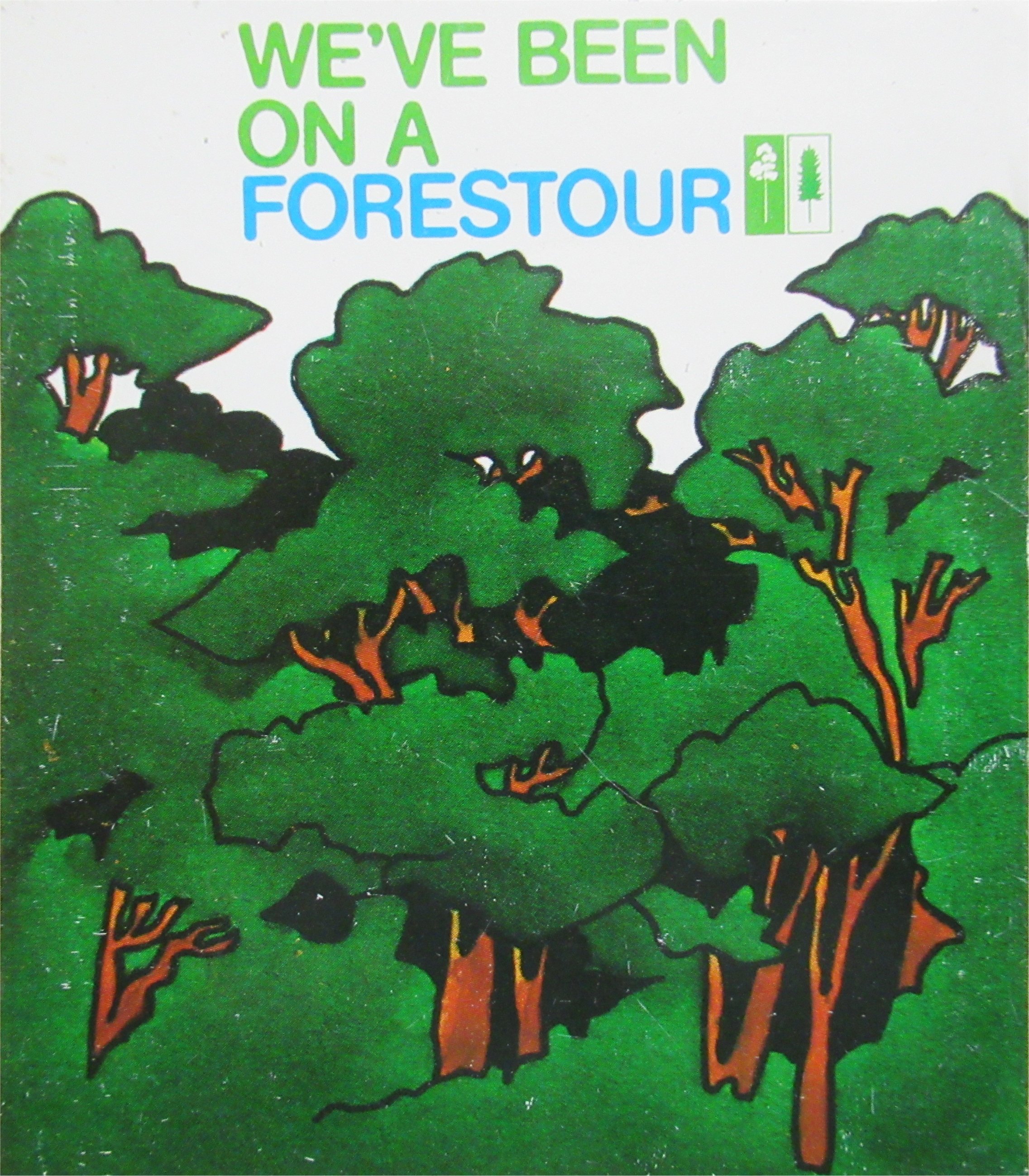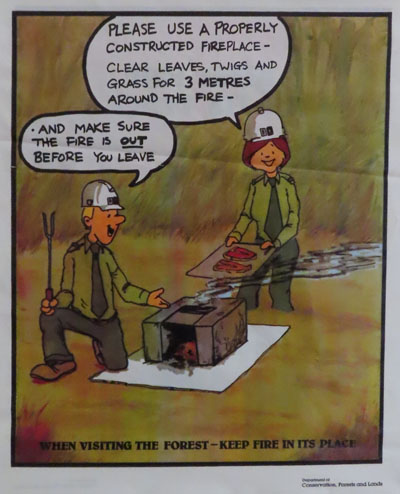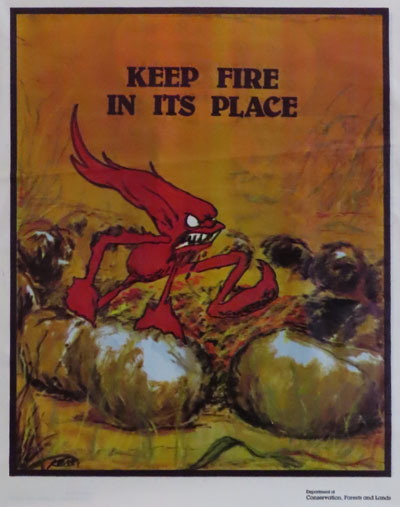Forestours - Recollections
Compiled by David Buntine
"Field staff conducted approximately 50 "Forestours" (guided forest drives), 70 spotlight tours of the forest by night, and forest excursions for 500 school groups and 100 other groups". Source: Annual Report FCV 1983-84
Forestours were launched by the Forests Commission of Victoria (FCV) at Lakes Entrance in January 1977. The concept was to offer free self-drive tours of forest activities under the guidance of local staff. The target audience was the general public with the intention of opening dialogue with the many people with minimal forestry exposure, and whose opinions, if any, were probably formed from the metropolitan media.
This was during a period of increasing public scrutiny into the future use of Victoria's public lands. The FCV had traditionally, very responsibly and successfully, undertaken its legislated task of providing a wide range of forest products for the expanding Victorian community, while also protecting the forests from fire. But in the 1970s pressure was mounting for greater reservations within the State’s forests, and in particular for a dramatic rise in the area of land dedicated as National Park.
The Land Conservation Act of 1970 established the Land Conservation Council (LCC) which was tasked with making recommendations about the use of public land across Victoria. The underlying theme to the LCC charter was an expectation of a dramatic increase in the area of land dedicated to non-production uses, but at the same time giving security to the timber industry by identifying land for future timber harvesting and plantations. The FCV was an active participant in the LCC, but the FCV operating model remained within its traditional strengths of fire and forest production and these were now under challenge. It was a period when people could have their say and campaign for alternative land use, in particular an increased commitment to environmental reserves of one type or another. The concept of Forestours was to open a dialogue with the general public and perhaps tone down some of the adverse comment that was drifting in the direction of FCV land management.
The first round of Forestours was launched from Lakes Entrance in 1977 and was very successful. From Lakes they spread first to Marlo and then to other centres across the State including Toolangi, Upper Yarra, Tallangatta, Corryong, Bright, Heywood and the Otways. Like Lakes Entrance, the target audience was usually at a holiday location and that location coincided with the potential for tours of forest activities. Many local staff were recruited over the years as guides for Forestours and the feedback received confirmed that both the guides and participants found the experiences to be friendly, rewarding and worthwhile.
As Forestours spread across the State, the FCV's Forest Environment and Recreation (FEAR) Branch in Melbourne played an increasing support and coordinating role, but execution remained at the local level. But all good things come to an end and, with the amalgamation of departments in the mid 1980s, Forestours fell by the wayside.
The Annual Report of 1982/83 records:
“In the past year, 43 Forestours from 12 country centres were patronized by 1897 persons. Such conducted tours, usually taking less than half a day, provided opportunities for inspection and advice of interesting features and operations in State forest. Persons travelled either by bus or in their own car”.
In its final (1983/84) report the Commission noted: "Field staff conducted approximately 50 "Forestours" (guided forest drives), 70 spotlight tours of the forest by night, and forest excursions for 500 school groups and 100 other groups."
The purpose of this paper is to record the rise and farewell of Forestours as seen through the eyes and memories of those involved. Contributions and personal recollections from other participants are welcome, particularly from the former FEAR Branch perspective.
Lakes Entrance 1977 & 1978, Tallangatta 1981 - David Buntine
In 1971 I was transferred from Bendoc to Working Plans Branch, based at Bairnsdale, replacing Peter Lawson as Management Planning Officer for the Eastern Division. Roly Parke was the Divisional Forester at the time, with Keith Gidley his Assistant. During my time at Bairnsdale Roly retired and Keith became Divisional Forester with Moray Douglas as the Assistant.
The 1970s was start of a period of progressive change for the FCV which culminated in its demise when amalgamated into a mega department in 1985. Dramatic changes to the face of forestry in Victoria followed that are continuing today, but that’s another story. I was caught up in these winds of change as my major task at Bairnsdale was to map the public forest estate of eastern Victoria as part of a commitment given by the FCV to the Land Conservation Council.
My other roles were to oversee the district forest management registers, undertake fire spotting flights - usually with Bob Hussey who owned the most suitable aircraft and was based at the Bairnsdale aerodrome - and carry out 35mm photography with Bob Hussey as requested by the districts. In order to speed up the photo turnaround, the actual development and printing of the photos was undertaken at the Divisional Office with the help of Dorothy Quinton, Keith’s secretary.
I also had an interest in public use of the forests and, with the Melbourne press not always complimentary about the FCV, I became increasingly aware that for each holiday period, thousands of people from the metropolitan area flocked to holiday destinations. I assumed that the majority of these people would know very little about forestry and what knowledge they had gleaned would be limited to personal experiences and/or what they had read in the metropolitan press.
Sometime in 1976 I read a promotion about some public tours run by Forestry NSW, and my attention returned to the thousands having holidays each year at the coastal resort town of Lakes Entrance in East Gippsland. People on holidays usually spend some of their time looking for things to do, particularly if the thing is free, family friendly and involves new experiences. So the idea was born. I approached Keith Gidley to test his support and, although happy with the idea, he issued a caveat that maybe we start with something small and see how it went. I enrolled Overseer Phil Morgan from Bruthen, who shared my fire spotting duties, and we developed the idea. Incidentally as we approached the date of the first tours, Keith realised that the Districts and Head Office were solidly on board and the caveat changed to “David – go for it!”, and so we did.
The initial concept developed was to run three half-day tours in the 1977 January school holidays starting from the foreshore next to the Princes Highway at Lakes Entrance. The tours would be free, they had to be relaxed and enjoyable, there would be multiple tours available each day and the only booking needed was to turn up, book into the tour you wanted, then travel in convoy in your own car. The only tour that had a numbers limit was the ‘nature walk’ (30 max.) to be conducted by Peter Fagg. Bairnsdale, Nowa Nowa, Bruthen and Orbost staff would be involved as tour guides. We dreamt up the name ‘Forestour’ in the Bairnsdale office.
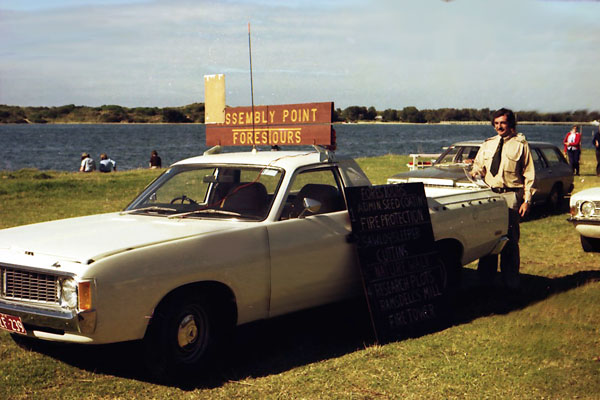
Ray McCrae at the Forestour assembly point - Lakes Entrance
1977
Source: D Buntine
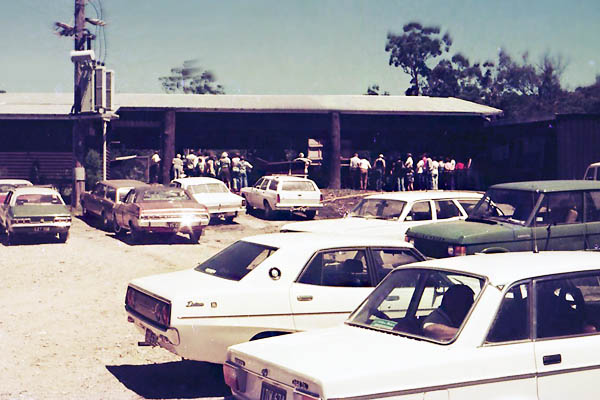
Forestour at Ramsdell's Sawmill - Nowa Nowa
1977
Source: D Buntine
The challenge was how to advertise the tours. One action was to befriend the local Bairnsdale Advertiser and The East Gippsland News. The Yeates family who owned these papers were very cooperative and on occasions Forestours made front page news (maybe sensational news was in short supply in those days). To reach the holiday makers, Phil and I did the foot slog and supplied leaflets to many motels and often walked through caravan parks handing out leaflets. Victorian Eastern Development Association also came on board and helped spread the word.
The next challenge was to predict what could go wrong on the day and provide for it. Unknowns like how many people would turn up, what if the cars split up on tour, what about breakdowns, people getting sick and would there be ‘green’ stirrers present to dominate discussions and so on. To be on the right side of the law we also let the local police know what was going on. So with these thoughts on our minds we decided for the first tours to have two radio-connected guide vehicles (subsequently reduced to one) per tour, one front and one back with provisions of freshwater, hard-hats where required and first aid kits.
We hoped to attract family groups, so having something for the kids was important and we made up hand-out kits for them with activities they could share with the group at the end of the tour. One item I remember was the ‘grow your own wattle seed’ packet that we obtained from the FCV''s Melbourne Show provisions. We also had tour assessment and feedback sheets for the participants and some suggestions were incorporated into future tours.
The first tours were held on 12 January 1977 when 49 cars with 172 people booked in for the four tours available that day. We ran this series of tours three times on Wednesday mornings in that month, and Phil and I were the guides for one of the forest activity tours. The consensus was that these first tours were very successful, further tours should follow in future holiday periods and be expanded to Marlo in January 1978. My limited records reveal that a total of more than 850 people participated in the Lakes Entrance tours of 1977.
My recollections of these times include:
- For the first tour, Head office, Divisional and District staff turned up as well as the press to see what was going to happen. I was told later we made it onto the metropolitan news that night.
- Participants were directed to the foreshore ‘tour office’, given a hand-out and directed to the guide car for their tour. The guide cars had ‘Forestour’ signs attached to their roof bars and were spaced along the foreshore.
- Keith Gidley was observing and cruising along the Princes Highway with others and he stopped to ask me how I was going to get all the tour cars onto the busy Princes Highway. My response was to act as a policeman in the middle of the highway and direct traffic. Keith observed, smiled and drove on.
- One family was having breakfast on their deck at a motel over the road. The father ran over to see what all the fuss was about and then asked us to wait while he organised his family to go on a tour.
- Phil Morgan’s normal daily duties include supervision of sleeper cutters in the Colquhoun Forest. He was therefore able to arrange a sleeper-cutting demonstration by one of his contactors as the tour party arrived. It was pre-arranged by Phil that the contactor would have a tree nearly cut down ready for our arrival. After we were out of our cars and at a safe distance with hard hats on, Phil gave an unobserved signal and the contractor would leap into action, fall the tree and Phil would express his amazement to the group. Thence we would move closer in to see how the contractor used his swing saw to prepare a sleeper.
- Phil was experienced in the use of a broad axe from his early days, and agreed to my request that it was time to sharpen his axes and give a display of broad axe cutting. After his first display he whispered to me that he was a bit out of practice and had nearly cut himself.
- At our first stop on the first tour, the Phytophthora sp. tolerance trial, one of the first questions asked of me came over as a loaded ‘green’ question and my heart sank. Not to be. The question was completely innocent and prompted by something the person had read in the press. Thereafter we were never aware that the tours raised any active interest from any of the ‘save the forest’ movement.
- We concluded some of the tours at a forest picnic spot and early feedback requested that the guides also stay for lunch with the participants so that discussions could be continued over lunch. We adopted that procedure and were bombarded with more questions and goodwill.
- The participants were overwhelmingly supportive of, and talkative with, the guides and we received copious thanks and praise for the tours. It was not uncommon for participants to come back for further tours.
- The kids loved being fitted with a hard hat, and the adults too for that matter.
- FEAR Branch provided special ‘I have been on a Forestour’ stickers which we put on all cars.
- Tour leaders met after each tour to compare notes and plan any improvements.
- In later tours we reactivated retired FCV Overseer Charlie Pettman to help on tours. Charlie had been involved in supervising work for crews of the unemployed during the Depression years in the Colquhoun Forest so he was able to give an excellent historic perspective to these forests.
- Our tour included an inspection of Jack Ramsdell’s sawmill at Nowa Nowa. To reduce the risk of injury we would turn up at 12 midday as the mill closed down for lunch. Jack then made the mill open for the tour participants. As a sideline Jack was a keen rock and gemstone collector so he was able to do a bit of his own business from his display room at the mill.
- On one of the later tours I had to get over 100 people up and down the old fire tower on Mt Nowa Nowa. That was a bit of a challenge.
I moved away from Bairnsdale in mid-1978 but I did return to Forestours briefly in 1981 when I ran one from Tallangatta and another from Corryong.
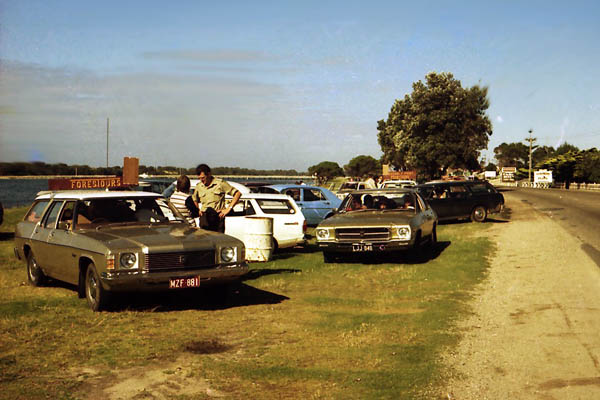
Brian Fry at the Forestour assembly point - Lakes Entrance
1977
Source: D Buntine
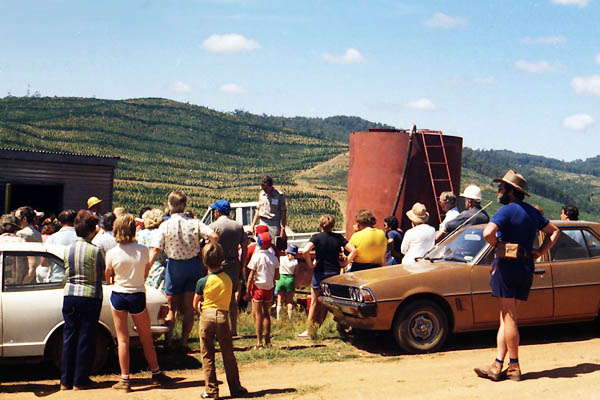
David Buntine with Forestour group at Shelley Firembombing Base
1981
Source: D Buntine
Other Memories
Shane Dwyer
I was involved with David running the tours out of Lakes Entrance over the holiday period when there were quite a few tourists around. People followed us in their own cars and I would guess that average numbers of people would be 30 to 40 people in 10 to 20 cars. I can only remember one motorcyclist, and she was an English tourist doing the big loop around Australia. I think the majority of people were families with young kids or middle-aged or grey-nomad couples.
I wonder if part of the attraction for people at the time was just to get out the bush on dirt roads. Even now I know people with 4wds that are reluctant to go off road (off road defined as not sealed!). I can’t ever recall getting much negativity on the tours like “why are you ruining the forest and killing baby possums etc etc”. It just never seemed to happen.
I can remember showing people an older Italian (I think) sleeper cutter and his wife using a swing saw in the Colquhoun Forest between Lakes and Nowa Nowa. The sleeper cutter I think liked showing off his skills. We also took people to a trial plot of different plantings on the Princes Highway near Nowa Nowa. The tours must have gone for a few years as I remember when we first went there some of the plantation looked like a wattle plantation but later the wattles had died off and the eucalypts had taken over. I think there must have been some pines as well because we used to quip that the pines seemed to thin themselves every year just before Christmas (there was no extra charge for the jokes).
Brian Fry
My memory is a bit foggy on the Forestours as I was only involved in the first ones due to my shift to the Victorian School of Forestry in August 1977.
I certainly recall that at the finish point at the Mississippi Creek picnic ground I found it hard to get away because groups were asking all sorts of questions that had come up due to the tour. We certainly aroused interest in our activities - there were no negative comments about harvesting.
On no trip did I get back to the Nowa Nowa office before about 3pm.
Sandy Jeffcoat took people to Mt Nowa Nowa tower and discussed fire protection and detection; Ray McRae took them to a sleeper cutting area; and I took them to logging sites and discussed management etc as well as answered all sorts of questions.
Peter Fagg
According to The East Gippsland News of 7 January 1977, I was the designated “experienced forest botanist” who led people on a two-hour nature trail walk in the Lake Tyers Forest Park. Prior to the first tour, I needed to identify a suitable place that could be reached by 2WD cars, and where there was a circular walking trail through the bush. I then identified the main plant species that I would later tell people about on the walk.
Participants were often children with their parents. Occasionally, there would be extra interest by seeing a Powerful Owl perched in a wattle tree, or an interesting insect on a bush. Generally, there were many questions - some of which I could answer. Often another local forester would join me to help with ‘crowd control’, such as Denis Read (who, like me, was based at Orbost).
I was involved in three tours in 1977, three in 1978, and two in 1979. I also helped with a Marlo-based tour on Tuesday 24 January 1978, Marlo being a small town at the mouth of the Snowy River. As David wrote, I think these Forestours were great (positive) publicity for the FCV.
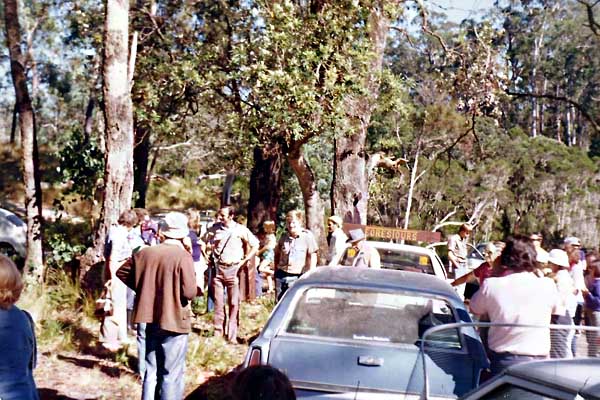
Forestour nature walk conducted by Peter Fagg
Denis Read left of centre
1978
Source: P Fagg
Ian Sebire
At the start of 1979 I became the Management Planning Officer in Bairnsdale following David Buntine’s move to the north-east of Victoria. I therefore, together with Phil Morgan, took over his role in the organisation and running of the Lakes Entrance Forestours. They continued to run for a number of years but ceased in the mid-1980’s, not too long after after the formation of Conservation, Forests and Lands. I believe the new organisation had little, if any, commitment to the concept, and Phil Morgan also retired at about this time.
In the early part of this period a demonstration of sleeper cutting continued to be well received by visitors. Initially we used one of the Saldaneri brothers from Lakes Entrance, but later on I think Mario Saulle from Bruthen was also involved. In later years, as sleeper cutting wound down in East Gippsland, it became more difficult to arrange this, so we used Bill Thomas of the Bruthen District crew to fall a tree or two and then Phil Morgan got out the broad axe and cut the resulting log into a sleeper.
Phil generally delivered the advertising posters to the caravan parks and motels around the district, and one of the most effective was a caravan park which always placed our posters on the inside of their toilet doors – they said that everyone visited there and had time to read the posters.
Mike Leonard
In late 1977 I was transferred to the FEAR Branch in Melbourne to work with the newly established Landscape Management Section, and with the three newly recruited US Landscape Architects. Not long after I reckon I accompanied FEAR’s then 2IC, Stuart Calder, to Gippsland to join a tour as observers. The plan, as I recall it, was to offer tours to greater Melbourne, as part of World Forestry Day (21 March) celebrations. The FCV was fairly ‘into’ WFD in that era.
Tours were then offered, over the next few years, in conjunction with WFD. Peter Young, again from memory, was the operations guru, but I have no recollection of how the tours were promoted. The tours assembled in Queens Park in Healesville, and on a few occasions, I filled a ‘tour leader’ role. Again from memory, several groups, of around 20 vehicles each, were marshalled before heading to either Toolangi or Upper Yarra Districts, to encounter a range of forest operations.
A final comment – at tour’s end (2-3+ hours later) people were generally pretty appreciative, but more than once I was slightly startled to be told how nice it was to spend a lovely day out in a national park.
Takeaways
